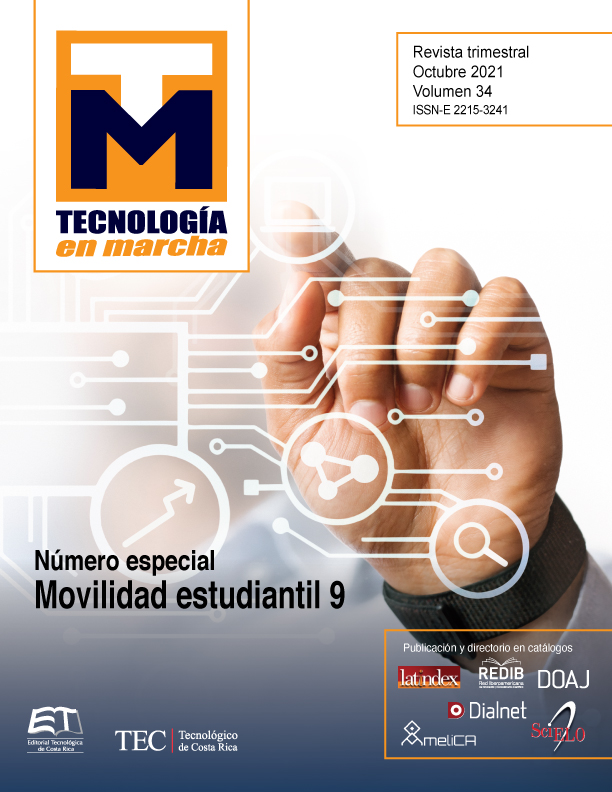Application of ICT and augmented reality as an initiative to promote the architectural heritage. Case studies from Spain in order to implementation in Costa Rican heritage contexts
Main Article Content
Abstract
Augmented reality is a technology that has been widely developed for academic, educational and entertainment purposes, several countries have used this technology to promote culture and urban tourism in heritage sites; it is a few explored technologies in Costa Rica, thus, theoretical and applied research would facilitate its consolidation in this country in order to promote and develop the architectural heritage.
This article, based on study cases, aims to investigate the operation, proposal and dissemination of mobile applications that use ICT for the tourism development environments with architectonic heritage interest. This study is based on a series of interviews with professionals from Autónoma de Madrid University who allowed defining the criteria and then, analyze the operation of the mobile apps at Segovia, Toledo and Barcelona cities, places that uses these new technologies to offer their cultural heritage. As a main conclusion, from this research was elaborated a series of conclusions and recommendations in order to implement these methods in heritage sites
Article Details

This work is licensed under a Creative Commons Attribution-NonCommercial-NoDerivatives 4.0 International License.
Los autores conservan los derechos de autor y ceden a la revista el derecho de la primera publicación y pueda editarlo, reproducirlo, distribuirlo, exhibirlo y comunicarlo en el país y en el extranjero mediante medios impresos y electrónicos. Asimismo, asumen el compromiso sobre cualquier litigio o reclamación relacionada con derechos de propiedad intelectual, exonerando de responsabilidad a la Editorial Tecnológica de Costa Rica. Además, se establece que los autores pueden realizar otros acuerdos contractuales independientes y adicionales para la distribución no exclusiva de la versión del artículo publicado en esta revista (p. ej., incluirlo en un repositorio institucional o publicarlo en un libro) siempre que indiquen claramente que el trabajo se publicó por primera vez en esta revista.
References
C. Prendes Espinoza, “Realidad aumentada y educación: análisis de experiencias prácticas,” no. 46, pp. 187–203, 2014, doi: 10.12795/pixelbit.2015.i46.12.
A. Arribas. A. Díez-Herrero, I. Gutiérrez-Pérez, and J. Vegas. “Desarrollo de un filtro de realidad aumentada para telefonía móvil sobre el patrimonio geológico de la provincia de Segovia.”. pp. 21-28, 2013.
J. L. Leiva-Olivencia, “Realidad aumentada bajo tecnología móvil basada en el contexto aplicada a destinos turísticos,” 2014.
J. L. L. Olivencia, A. G. Plaza, and C. R. Jiménez, “Sistemas de recomendación para realidad aumentada en un sistema integral de gestión de destinos,” vol. 0, no. 14, pp. 69–81, 2012.
J. L. Caro, A. Luque, and B. Zayas. “Nuevas tecnologías para la interpretación y promoción de los recursos turísticos culturales,” PASOS. Revista De Turismo Y Patrimonio Cultural, vol.13, no.4, pp. 931-945, 2015. Available: https://www.redalyc.org/articulo.oa?id=88140288014
MEP, “Flora and Fauna in Costa Rica | Ministerio de Educación Pública, 2018. [Online]. Available: https://www. mep.go.cr/educatico/flora-and-fauna-costa-rica. [Accessed: 2020]
MEP, “¿Qué hay de nuevo en Educatico? | Ministerio de Educación Pública,” 2018. [Online]. Available: https:// www.mep.go.cr/educatico/nuevo-educatico. [Accessed: 2020]
W. Montes, “Tecnología y emprendimiento: WOW Emotions,” 2018. [Online]. Available: https://www.larepublica.net/noticia/tecnologia-y-emprendimiento-wow-emotions. [Accessed: 25-Mar-2020]
“La Realidad Aumentada en Costa Rica,” 2019. [Online]. Available: http://smartechgroup.es/la-realidadaumentada-en-costa-rica/. [Accessed: 25-Mar-2020]
ITNow, “Startup tica, pionera en realidad aumentada,” 2017. [Online]. Available: https://revistaitnow.com/ startup-tica-pionera-realidad-aumentada/. [Accessed: 25-Mar-2020]
M. Vargas, “Realidad aumentada hace accesibles reliquias del Teatro Nacional,” 2017. [Online]. Available: https://www.nacion.com/tecnologia/moviles/realidad-aumentada-hace-accesibles-reliquias-del/ AHHHIVQ5UBG5JPIXVV4LJHBVKM/story/. [Accessed: 26-Mar-2020]
D. Porras and E. Solano, “La implementación de la realidad aumentada como valor agregado para la puesta en valor y difusión del paisaje urbano histórico,” pp. 147–156, 2019.
B. Tato and J. Villejas, “Escenarios urbanos,” p. 21, 2011.
E. P. Aguiar, “Observación participante: una introducción.,” pp. 80–89, 2015.
A. Palacios (private communication), 2019.
C. Hidalgo. (private communication), 2019.
D. Barrado (private communication), 2019.
D. A. Barrado-Timón and C. Hidalgo-Giralt, “The Historic City, Its Transmission and Perception via Augmented Reality and Virtual Reality and the Use of the Past as a Resource for the Present: A New Era for Urban Cultural Heritage and Tourism,” vol. 11, no. 10, p. 2835, May 2019, doi: 10.3390/su11102835.
D. M. Sastre, I. R. Martín, and L. R. Martín, “La experiencia 5G en el turismo: el caso de Segovia, Ciudad Patrimonio de la Humanidad,” no. E24, pp. 336–348, 2019.
“La realidad aumentada llega al Alcázar,” 2019. [Online]. Available: https://www.eldiasegovia.es/noticia/ ZB658E632-EB1A-8E3E-81102DD0874B0E55/201905/la-realidad-aumentada-llega-al-alcazar. [Accessed: 26-Mar-2020]
D. Fonseca Escudero, E. Redondo Domínguez, and F. Valls Dalmau, “Motivación y mejora académica utilizando realidad aumentada para el estudio de modelos tridimensionales arquitectónicos,” vol. 17, no. 1, pp. 45–64, 2016.
Ajuntament de Barcelona, “El espacio de encuentro con la gestión de la ciudad de Barcelona.,” 2019. [Online]. Available: https://ajuntament.barcelona.cat/es. [Accessed: 2019]
elPeriodico, “Barcelona apuesta por las TIC para impulsar turismo personalizado de calidad,” 2013 [Online]. Available: https://www.elperiodico.com/es/barcelona/20130521/barcelona-apuesta-por-las-tic-para-impulsarturismo-personalizado-de-calidad-2396086. [Accessed: 2019]
ESMARTCITY, “Una plataforma de gestión, turismo inteligente y realidad aumentada vertebran Toledo como smart city,” 27-Sep-2019. [Online]. Available: https://www.esmartcity.es/2018/09/27/plataforma-gestion-turismo-inteligente-realidad-aumentada-vertebra-toledo-como-smart-city. [Accessed: 2019]
I. M. Sánchez and A. A. N. Newball, “La ciudad escondida. Toledo, laboratorio de comunicaciónn transme-dia,” vol. 31, no. 1, pp. 806–827, 2015.

